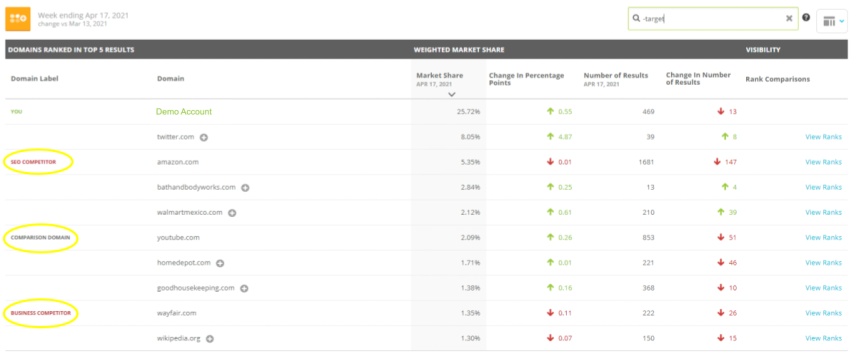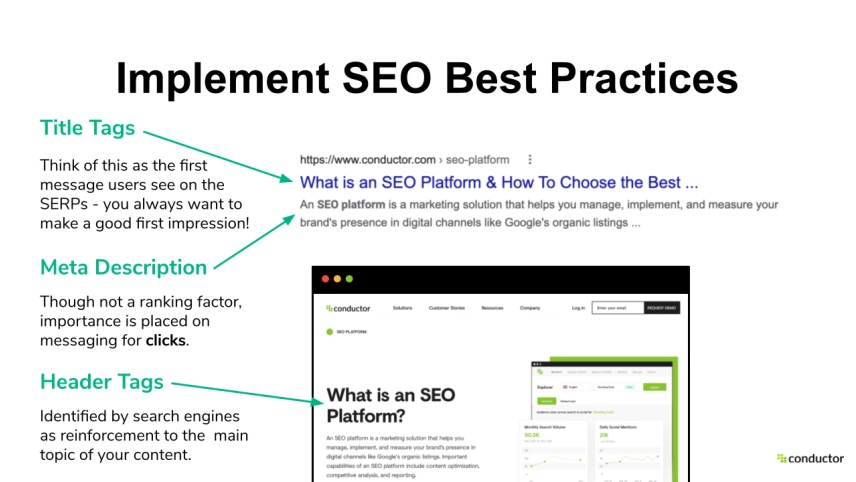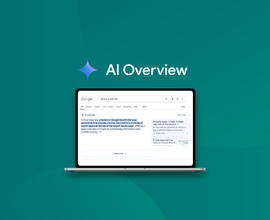Supercharge your Content with SEO
Optimize your SEO content in 5 easy steps. Learn to improve your content writing & strategy to get discovered by your audience & optimize rank.
There was so much valuable information packed into just 45 minutes in our recent webinar, “Supercharge Your Content With SEO,” that we’re eager to share it again here with a recap of the valuable tips attendees learned from Mari Irby, SEO Success Manager, and Allie Bhutani, Director of Brand here at Conductor.
If you’re incorporating SEO into your content strategy, your content is all but guaranteed to perform better. SEO gives you the agility to execute content more efficiently and effectively when you make it a key pillar of your content. Once you’ve baked SEO into your processes, you’ll be able to optimize both reach and performance while effectively measuring and reporting your successes.
Learn How to Optimize Your Content with SEO
To succeed with any recipe, you need to follow the right steps with the right ingredients. Skip a step or an ingredient, and it’s not going to feed you the results you’re hoping for.
That’s just as true when you’re cooking up great content. Get ready to supercharge your content kitchen with these five steps.
Determine Your Topic
KeywordKeyword
A keyword is what users write into a search engine when they want to find something specific.
Learn more research is the first step in the content “assembly line.” It’s foundational. When you take the time to understand what your audience is searching for—uncovering their intent—you can use that information to craft the content that very clearly feeds them what they’re craving. Understanding your buyer’s intent is crucial.
Understand Your Audience
If you don’t understand your audience and what they’re looking for, who is your content really for? You need to take into account the kinds of audiences that your topics will attract, and make sure you’re writing content in the language those audiences would use themselves. Craft the content that suits their palates.
Identify Your Competitors

Take a look at who’s already showing up at the top of the search engine results page (SERP) for your topics and keywords. Why are they there? There are different kinds of results—news carousels, answer boxes, featured snippetsFeatured Snippets
Featured snippets are highlighted excerpts of text that appear at the top of a Google search results page in what is known as ‘Position 0’.
Learn more, etc. These might all be owned by different kinds of domains that you might initially think are your competitors.
But are they? You need to be able to differentiate between SEO competitors and business competitors, because they don’t always overlap. Your competitors might be different across multiple verticals. Determine who owns the space.
The screenshot above comes from a demo account within Conductor and highlights different competitors that appear for different reasons. Examining these reasons is an important part of understanding your true competitive landscape.
Implement SEO Best Practices

You may already be familiar with on-page elements like title tags, meta descriptions and header tags. These can be standardized across your website and help draw the right audiences to your relevant content.
Your site structure is also important. If a website doesn’t clearly state its purpose or spell out what you can expect to find, it’s not going to be as valuable to you as a user. Bake that UX into your content with on-page elements that help your users.
That first blue link you see on a SERP is the title tag. The meta descriptionMeta Description
The meta description is one of a web page’s meta tags. With this meta information, webmasters can briefly sketch out the content and quality of a web page.
Learn more is the brief description that appears beneath the link. Meta descriptions aren’t technically ranking factors, but they feed into better click-through rates, which are ranking factors. That’s because they’re indicators to Google that your site is the right one to deliver for a searcher’s query.
The third element is the header tag—the different titles you see once you land on the page itself. They’re slightly different from one another, but they’re all important in tying back to your main theme and topic.
All this underscores the importance of spending time on keyword research to understand the language and terms that customers care about—and that they’ll be searching for.
Evaluate Your Performance

It’s no secret that demonstrating ROI can be challenging, but it’s an imperative to monitor your performance so that you know what’s working and what’s not. All this information can help you build your content around your customers’ interests and align your strategy with what they look for. And remember that it’s so much easier and more effective when you perform your keyword research and competitive analysis upfront.
Evaluate your performance over time to determine the kinds of changes you need to make to match your customers’ intent. You can get more clicks, more registrations or more sales when you start with smart SEO.
Outline for Seamless Content Creation
So many marketers try to tack SEO onto the end of content execution: “Let’s SEO it!”
Those guys have it backwards. Bake SEO into your content creation process for robust, supercharged content. Let’s talk about how to do it the right way with some of the best practices and successes we use here at Conductor.
Define Your Team
You can’t bake a cake without sugar, flour and eggs, and you can’t execute a supercharged content strategy with SEO unless you have the right team in place. Establish each member’s contributions and name your key stakeholders for each piece of content before you kick it off.
The typical team might include a copywriter, an SEO specialist, a designer, a UX designer/developer and a digital marketer. SEOs, copywriters, and digital marketers are all really important to incorporate into any content creation process. It ensures that you’re factoring in keyword research and competitive analysis, plus looking at all of these SEO elements as you’re brainstorming your contact topics and formats. Your digital marketer will help you establish those KPIs and what specific success metrics mean for a particular piece.
Developers and designers may play a smaller role in publishing a blog post but a much larger role in a net-new web page or a quiz. Bring them into any design-intensive projects at the outset.
Your team can establish the goals for your asset and determine the shape it takes—whether it’s to win organic traffic or pull leads through a gated asset. Think about the format at the beginning. Your SEO research may tell you the formats that rank best for a particular topic or which topics typically have more video content than blog posts.
And of course, consider your audience. Who do you want to reach, and what are they searching for? (Notice that’s the opposite of starting with your own goals.) Consider their perspective and how you can best answer their questions with your content.
Then you can think about your own goals. What do you want them to do, convert? Consume another asset? Understand their journey in interacting with your content. Document your objectives and align them with KPIs to measure performance.
Finally, the last step in this pillar is to hold a kickoff meeting. Get your team together to brief and scope the project. You’ll want to accomplish these four things:
- Outline your main objectives and align the team.
- Define your target audience.
- Establish your message.
- Set up your timeline.
Starting with these clear parameters allows each team member to understand what’s expected of them. Here at Conductor, we’ve found these kickoff meetings extremely helpful in recognizing potential roadblocks, like scheduling conflicts, and potential opportunities, like cross-promotion opportunities with complementary assets.
Brainstorm
With the second pillar, it’s time to get creative. Brainstorming at the beginning of the process increases the level of creativity and gets stakeholders bought into the concept from the get-go. To make these sessions productive, share a briefingBriefing
A briefing is a short meeting or an introduction to a new topic. It is mainly used in the areas of military, aviation and diving as well as in online marketing and advertising.
Learn more document in advance so that everyone comes prepared with ideas and examples, having reviewed and digested the details and toyed with a few concepts in advance.
Bust out the whiteboards and sticky notes (or Zoom and digital whiteboard tools if you’re remote), and prepare to wrap the session with an established creative direction and a content format.
Pour the best of your brainstorming results into a content brief. Your copywriter will develop an outline and your SEO will bring in components to flesh out the outline. Incorporate title suggestions, meta descriptions, H2 tags and keywords. This way, you’re not tacking keywords on at the end of the creative process as an afterthought. You’ll take a comprehensive approach that considers SEO as an important factor in your strategy.
For highly visual pieces, like a new web page or an E-book, bring your content and design teams together to collaborate. You can avoid a bunch of back-and-forth by encouraging everyone to work in tandem, with the content team crafting the copy while your design team is assembling rough wireframes. Everyone has the ability to work together and adjust what they’re doing to produce the best possible content.
Review + Distribute
Before you publish your shiny new asset, include a review cycle to make the launch seamless. Review the copy; scrutinize the design; triple-check the SEO. For interactive content, set up a staging site so you can preview live content and make any adjustments before things go live. Make sure everything renders properly on desktop and mobile, and test in a variety of browsers.
The SEO review is a step you may not be used to, but it’s extremely valuable. Checking the SEO ensures you’re not missing a meta description that will torpedo your rankingsRankings
Rankings in SEO refers to a website’s position in the search engine results page.
Learn more, that your H tags are properly implemented and your keywords are integrated correctly.
Tada! You’re done! Well, almost. First, it’s time to review, measure and refine your content. Revisit the goals you established in your team kickoff. Benchmark your performance against similar past content or against competitors, depending on your KPIs and what information you have. Assess how well you’re ranking for your top keywords.
SERP isn’t the only marker of success. Maybe you earned the answer box or a featured snippet. Evaluate your successes and your disappointments in organic performance, lead conversions and other important metrics.
Don’t stop by crunching the numbers in a single moment in time. The results may climb or dip over time, so it’s important to keep tabs on the asset—particularly an evergreen one. Have your rankings dropped off for any top keywords? Did a competitor snap up the answer box? Are there adjustments you can make to turn those trends around?
Ongoing refinement includes continual updates to meta descriptions, header tags—whatever needs tweaking when performance lags.
Conclusion
You can see that it’s not that difficult to incorporate SEO from the outset of the creative process, but it makes all the difference once you hit “publish” because you’ve absorbed it into the workflow to inform the content instead of sprinkling some keywords on at the end.
SEO isn’t the icing, it’s the cake. Make SEO a pillar of your content, optimizing its reach and performance, and you’ll be able to measure and report on your KPIs with an SEO platform—not just for an individual asset, but for topics, libraries, entire blogs and even your marketing strategy as a whole.
The results you can achieve when you dig into SEO make an SEO platform an incredibly worthy investment in the success of your marketing. Bon Appetit!







